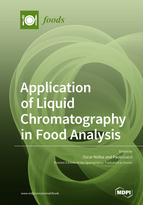Application of Liquid Chromatography in Food Analysis
A special issue of Foods (ISSN 2304-8158). This special issue belongs to the section "Food Analytical Methods".
Deadline for manuscript submissions: closed (31 December 2018) | Viewed by 54127
Special Issue Editors
2. Research Institute in Food Nutrition and Food Safety, Universitat de Barcelona, Av. Prat de la Riba 171, Edifici Recerca (Gaudí), E-08921 Santa Coloma de Gramenet, Spain
Interests: food authentication; food characterization; food classification; food fraud identification; secondary metabolites; polyphenols; foodomics; bioactive compounds; liquid chromatography; mass spectrometry; high resolution mass spectrometry; ambient mass spectrometry; capillary electrophoresis; chemometrics
Special Issues, Collections and Topics in MDPI journals
Interests: food authentication; food contaminants; edible oil characterization; food fraud identification; liquid chromatography; mass spectrometry; bioactive compounds
Special Issues, Collections and Topics in MDPI journals
Special Issue Information
Dear Colleagues,
Food products are very complex mixtures consisting of naturally-occurring compounds and other substances, generally originating from technological processes, agrochemical treatments, or packaging materials. Several of these compounds (e.g., veterinary drugs, pesticides, mycotoxins, etc.) are of particular concern because, although they are generally present in very small amounts, they are nonetheless often dangerous to human health. On the other hand, improved methods for the determination of authenticity, standardization, and efficacy of nutritional properties in natural food products are also required to guarantee their quality and for the growth and regulation of the market. Thus, food safety and food authentication are hot topics for both society and the food industry. Nowadays, liquid chromatography with ultraviolet (LC-UV) detection, or coupled to mass spectrometry (LC-MS) and high-resolution mass spectrometry (LC-HRMS), are among the most powerful techniques to address food safety issues and to guarantee food authenticity in order to prevent frauds. In this Special Issue, the role of liquid chromatography techniques in food analysis (including food safety issues, determination of nutritional properties, and authentication and prevention of frauds) will be addressed. Both, original research articles and reviews are welcome.
Dr. Oscar Núñez
Dr. Paolo Lucci
Guest Editors
Manuscript Submission Information
Manuscripts should be submitted online at www.mdpi.com by registering and logging in to this website. Once you are registered, click here to go to the submission form. Manuscripts can be submitted until the deadline. All submissions that pass pre-check are peer-reviewed. Accepted papers will be published continuously in the journal (as soon as accepted) and will be listed together on the special issue website. Research articles, review articles as well as short communications are invited. For planned papers, a title and short abstract (about 100 words) can be sent to the Editorial Office for announcement on this website.
Submitted manuscripts should not have been published previously, nor be under consideration for publication elsewhere (except conference proceedings papers). All manuscripts are thoroughly refereed through a single-blind peer-review process. A guide for authors and other relevant information for submission of manuscripts is available on the Instructions for Authors page. Foods is an international peer-reviewed open access semimonthly journal published by MDPI.
Please visit the Instructions for Authors page before submitting a manuscript. The Article Processing Charge (APC) for publication in this open access journal is 2900 CHF (Swiss Francs). Submitted papers should be well formatted and use good English. Authors may use MDPI's English editing service prior to publication or during author revisions.
Keywords
- liquid chromatography
- food safety
- food authentication
- nutritional properties
- UV-detection
- mass spectrometry
- high-resolution mass spectrometry








